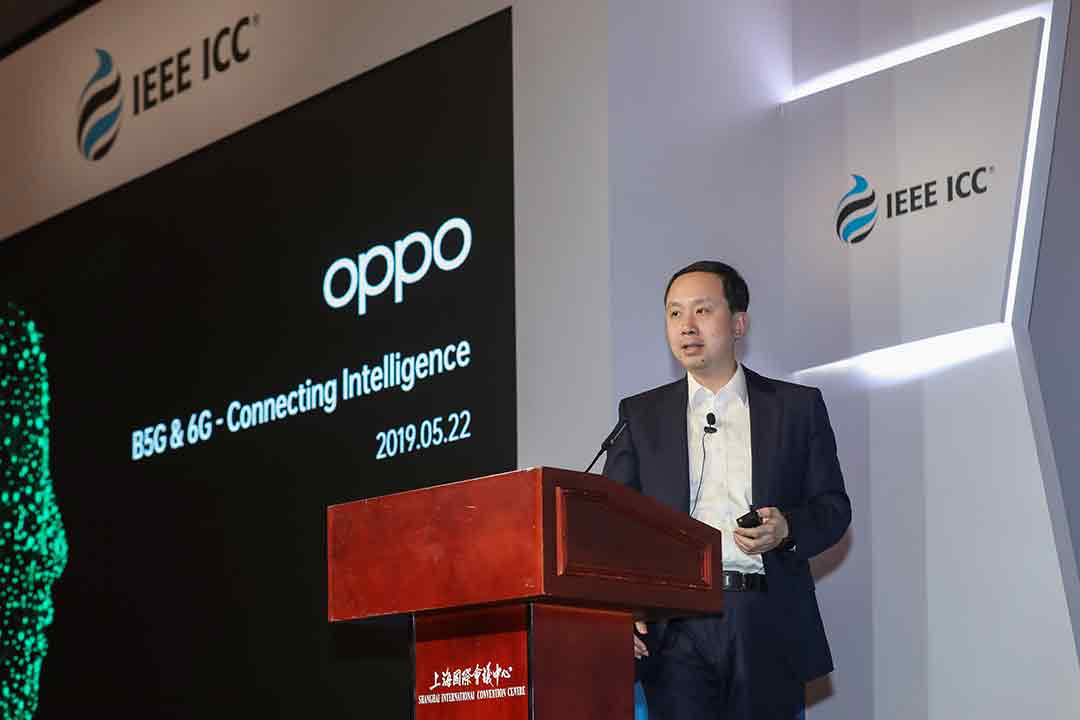OPPO laid out its vision for a future of connected intelligence this week at the 53rd IEEE International Conference on Communications (ICC), held in Shanghai from May 20th to 24th. With a 2019 theme of Empowering Intelligent Communications, ICC brings together top global experts from industry and academia to share visions and ideas on the latest technologies and innovations in communications. On May 22nd, Henry Tang, Director of Standards Research and Chief 5G Scientist at OPPO, delivered a keynote speech at the conference underscoring OPPO’s commitment to driving future generations of connectivity. In his speech, titled B5G (Beyond 5G) & 6G:Connecting Intelligence, Tang offered a preview of a future where, “after the launch of 5G, as AI and telecommunications technologies continue to empower and improve each other, they will enable true interconnectivity between humans, things and intelligence.”
 Henry Tang, Director of Standards Research and Chief 5G Scientist of OPPO, delivers a keynote speech
Henry Tang, Director of Standards Research and Chief 5G Scientist of OPPO, delivers a keynote speech
During his keynote, Tang shared OPPO’s outlook and vision for the evolution of an “intelligence era” through next-generation connectivity. Tang described this evolution of connected intelligence – from 5G to B5G to 6G – as a system “for the AI, by the AI and of the AI”, and a transformation which will dramatically change the way we live and work.
In the short-term – the “for the AI” stage – 5G is enabling new connections between humans and things that can be leveraged to bolster a range of existing vertical applications like consumer IoT, enterprise IoT and HD video. At the same time, the adoption of AI businesses like autonomous driving, AR and VR is poised to accelerate. In the face of autonomous driving, ubiquitous reality and other AI applications with high requirements for computational power, storage and low-latency, 5G opens up real-time, high-speed channels to realize capabilities like “cloud perception, cloud learning and cloud collaboration”.
In the future, Tang envisions a world that is shared by human users and intelligent agents, with B5G and 6G as key enablers of “Human-Thing-Intelligence” interconnectivity. As technologies evolve, at the next stage – “by the AI”- the goal is to enhance the 5G system by introducing AI capabilities like neural networks and machine learning. The implementation of AI will address imperfections and inaccuracies in existing wireless telecommunications theories, making the 5G ecosystem faster, more delicate and more efficient in order to meet the increasing demands on network performance.
Looking into the more distant ‘6G era’, Tang explained that more and more businesses will be run largely without human intervention. In this intelligent future, scenarios in which machines and AI directly interface will also increase, thereby creating demand for swarming system, whose capacities are greater than those of its individual agents. Henry Tang called that “collective intelligence“. One new business model that will emerge during this “of the AI” stage will address the intelligent connections between smart devices. Apart from traditional data such as media data, sensor data, and control data, a new type of data that will occupy the 6G network will be AI-driven “smart” transmissions, which means devices will be capable of sharing and conveying AI messages among themselves. As we are currently experiencing with 5G, 6G technologies will again need to overcome a series of challenges to boost performance, such as dramatically improving speed, latency, reliability, coverage, energy efficiency, connection density, accuracy and security. “With the iterative evolution of technologies, the whole of human society – and indeed the world around us – will realize an unprecedented level of interconnectivity. We at OPPO welcome and embrace this exciting new opportunity to help usher in a new era of connected intelligence,” Tang said.
As a pioneer in 5G, OPPO established its first dedicated 5G team in 2015 and has since been investing heavily in the next generation technology across areas such as standardization, R&D and applications. With a long-standing commitment to the global development of 5G, OPPO is one of the top contributors to 3GPP among smartphone brands, having submitted more than 2,800 technical proposals to the authoritative 5G standards organization.
This month, OPPO further demonstrated its leading position in the emerging era of intelligent connectivity with the launch of Reno 5G, the company’s first 5G smartphone and Europe’s first commercially-available 5G handset. First going live in Switzerland on May 1st on the Swisscom network, Reno 5G launched in the UK on May 20th in partnership with EE and is set to roll out to additional markets soon. OPPO is also actively exploring the convergence of 5G with AI, big data, cloud and other key frontier technologies, and will continue to work with partners around the world to bring next-generation products and services to users everywhere.
At ICC 2019, OPPO showcased its leading 5G capabilities onsite through the new Reno 5G. Visitors to the OPPO booth were given the opportunity to experience 5G cloud gaming on Reno 5G devices connected to a 5G network. Through an ultra-fast, low-latency 5G connection, Reno 5G lets users play HD games that are loaded and run entirely on the cloud, enabling smooth, cutting-edge gaming experiences without the hassle of downloading large files beforehand.
.jpg)


